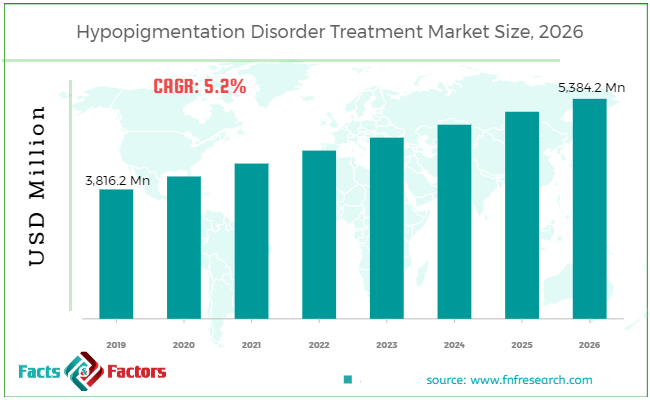Search Market Research Report
Hypopigmentation Disorder Treatment Market Size, Share Global Analysis Report, 2020–2026

Hypopigmentation Disorder Treatment Market by treatment (topical drugs, laser, chemical peels, microdermabrasion and others (phototherapy, etc.)), disease indication (Vitiligo, albinism and others), and end user (hospitals, aesthetic clinics & dermatology centers, and others): Global Industry Outlook, Market Size, Business Intelligence, Consumer Preferences, Statistical Surveys, Comprehensive Analysis, Historical Developments, Current Trends, and Forecast 2020–2026
Industry Insights
[180+ Pages Report] According to the report published by Facts Factors, the global hypopigmentation disorder treatment market size was worth around USD 3,816.2 Million in 2019 and is predicted to grow to around USD 5,384.2 Million by 2026 with a compound annual growth rate (CAGR) of roughly 5.2% between 2020 and 2026. The report analyzes the global hypopigmentation disorder treatment market drivers, restraints/challenges, and the effect they have on the demands during the projection period. In addition, the report explores emerging opportunities in the hypopigmentation disorder treatment market.

The hypopigmentation disorder treatment market report analyzes and notifies the industry statistics at the global as well as regional and country levels in order to acquire a thorough perspective of the entire Hypopigmentation Disorder Treatment market. The historical and past insights are provided for FY 2016 to FY 2019 whereas projected trends are delivered for FY 2020 to FY 2026. The quantitative and numerical data is represented in terms of value (USD Million) from FY 2016 – 2026.
 Key Insights from Primary Research
Key Insights from Primary Research
- According to the primary CXO’s of the global Hypopigmentation Disorder Treatment market, the market is estimated to witness a substantial growth of nearly 2.0% over the forecast period.
- The market was valued at USD 3,816.2 Million. The market is expected to grow above a CAGR of 5.2% and is anticipated to reach over USD 5,384.2 Million by 2026.
- On the basis of the end user segment, the Segment of cosmetic clinics & dermatology centers dominated the global market. The phenomenon is likely to continue over the forecast period. Factors that drive the segment are increasing the number of qualified doctors who can perform cosmetic procedures to treat pigmentation disorders and the number of patients with skin pigmentation is increasing.
- Asia Pacific market is expected to be the best growing region for biomedical warming and thawing devices over the forecast period.
- By geography, the North America region headed the market with a share of above 36.53%, in 2019
 Key Recommendations from Analysts
Key Recommendations from Analysts
- Growing lifestyle spending as well as rising understanding among humans drives growth in the market for treatment of pigmentation disorders. In addition, the growing prevalence of skin disorders is driving the rise in demand for treating hypopigmentation disorder.
- The strategic developments such as regional expansion, product innovations and on-going research and developments by the major companies such as Allergan, Alvogen, Episciences Inc., Obagi Cosmeceuticals LLC,etc is likely to boom the market’s growth over the up-coming years.
Our analysts advise that the Asia Pacific region will most likely witness a significant growth attributed to the growing demand for Hypopigmentation Disorder Treatment.
The quantitative data is further underlined and reinforced by comprehensive qualitative data which comprises various across-the-board market dynamics. The rationales which directly or indirectly impact the Hypopigmentation Disorder Treatment industry are exemplified through parameters such as growth drivers, restraints, challenges, and opportunities among other impacting factors.
Throughout our research report, we have encompassed all the proven models and tools of industry analysis and extensively illustrated all the key business strategies and business models adopted in the Hypopigmentation Disorder Treatment industry. The report provides an all-inclusive and detailed competitive landscape prevalent in the Hypopigmentation Disorder Treatment market.
 Report Scope
Report Scope
Report Attribute |
Details |
Market Size in 2019 |
USD 3,816.2 Million |
Projected Market Size in 2026 |
USD 5,384.2 Million |
CAGR Growth Rate |
5.2% CAGR |
Base Year |
2019 |
Forecast Years |
2020-2026 |
Key Market Players |
Allergan, Alvogen, Episciences Inc., Obagi Cosmeceuticals LLC, Pierre Fabre, Rxi Pharmaceutical Corporation and SkinCeuticals, and Others |
Key Segment |
By Treatment, Disease, End User, and Region |
Major Regions Covered |
North America, Europe, Asia Pacific, Latin America, and the Middle East & Africa |
Purchase Options |
Request customized purchase options to meet your research needs. Explore purchase options |
The report utilizes established industry analysis tools and models such as Porter’s Five Forces framework to analyze and recognize critical business strategies adopted by various stakeholders involved in the entire value chain of the Hypopigmentation Disorder Treatment industry. The Hypopigmentation Disorder Treatment market report additionally employs SWOT analysis and PESTLE analysis models for further in-depth analysis.
The report study further includes an in-depth analysis of industry players' market shares and provides an overview of leading players' market position in the Hypopigmentation Disorder Treatment sector. Key strategic developments in the Hypopigmentation Disorder Treatment market competitive landscape such as acquisitions & mergers, inaugurations of different products and services, partnerships & joint ventures, MoU agreements, VC & funding activities, R&D activities, and geographic expansion among other noteworthy activities by key players of the Hypopigmentation Disorder Treatment market are appropriately highlighted in the report.
The Hypopigmentation Disorder Treatment market research report delivers an acute valuation and taxonomy of the Hypopigmentation Disorder Treatment industry by practically splitting the market on the basis of different types, categoryand regions. Through the analysis of the historical and projected trends, all the segments and sub-segments were evaluated through the bottom-up approach, and different market sizes have been projected for FY 2020 to FY 2026. The regional segmentation of the Hypopigmentation Disorder Treatment industry includes the complete classification of all the major continents including North America, Latin America, Europe, Asia Pacific, and Middle East & Africa. Further, country-wise data for the Hypopigmentation Disorder Treatment industry is provided for the leading economies of the world.
Hypopigmentation is lack of pigment on the skin, or light. This may occur or be put all over the body. Several patches or areas on the skin can appear white at localized hypopigmentation. Patch size and shape can differ considerably. And the melanin itself decreases in individuals with hypopigmentation. Hypopigmentation can also be caused by a reduction in amino acid tyrosine. Melanocytes produce tyrosine for the development of melanin. Hypopigmentation may occur in people of all races, but in people with darker skin it may be more apparent due to the dissimilarity between natural skin color and white patches. The hypopigmentation triggers several different causes. The most common condition occurs as a result of skin injury or trauma. Blisters, burns and infections may all cause skin damage, and hypopigmentation. Cosmetic skin treatments such as chemical or laser peeling can also cause hypopigmentation if the procedure is improperly performed.
The Hypopigmentation Disorder Treatment market is segmented into treatment, disease indication, end user and region segment. The treatment segment is segmented into topical drugs, laser, chemical peels, microdermabrasion and others (phototherapy, etc.). The disease indication segment is divided into Vitiligo, albinism and others. The end user segment is segmented into hospitals, aesthetic clinics & dermatology centers, and others.
 Some of the essential players operating in the:
Some of the essential players operating in the:
- Allergan
- Alvogen
- Episciences Inc.
- Obagi Cosmeceuticals LLC
- Pierre Fabre
- Rxi Pharmaceutical Corporation
- SkinCeuticals
The taxonomy of the Hypopigmentation Disorder Treatment industry by its scope and segmentation is as follows:
 Treatment Segment Analysis
Treatment Segment Analysis
- Topical Drugs
- Laser
- Chemical Peels
- Microdermabrasion
- Others (phototherapy, etc.)
 Disease Indication Segment Analysis
Disease Indication Segment Analysis
- Vitiligo
- Albinism
- Others
 End user Segment Analysis
End user Segment Analysis
- Hospitals
- Aesthetic Clinics & Dermatology Centers
- Others
 Regional Segmentation Analysis
Regional Segmentation Analysis
- North America
- The U.S.
- Canada
- Europe
- Germany
- The UK
- France
- Spain
- Italy
- Rest of Europe
- Asia Pacific
- China
- Japan
- India
- South Korea
- Southeast Asia
- Rest of Asia Pacific
- Latin America
- Brazil
- Mexico
- Rest of Latin America
- Middle East & Africa
- GCC
- South Africa
- Rest of Middle East & Africa
Industry Major Market Players
- Allergan
- Alvogen
- Episciences Inc.
- Obagi Cosmeceuticals LLC
- Pierre Fabre
- Rxi Pharmaceutical Corporation
- SkinCeuticals
Frequently Asked Questions

Copyright © 2024 - 2025, All Rights Reserved, Facts and Factors


